概述
目前css布局方案中,网格布局可以算得上是最强大的布局方案了。它可以将网页分为一个个网格,然后利用这些网格组合做出各种各样的布局。
基本概念
在学习grid布局之前,我们需要了解一些基本概念
1.容器和项目
采用网格布局的区域,称为“容器”。容器内部的采用网格定位的子元素称为“项目”
<div class="wrapper">
<div class="item">1</div>
<div class="item">2</div>
<div class="item">3</div>
</div>上面的代码中,wrapper就是容器,item就是项目
1.1 行、列和单元格
容器里面的水平区域称为“行”,垂直区域称为“列”,行列重叠出来的空间组成单元格

1.2 网格线
划分网格的线,称为”网格线“
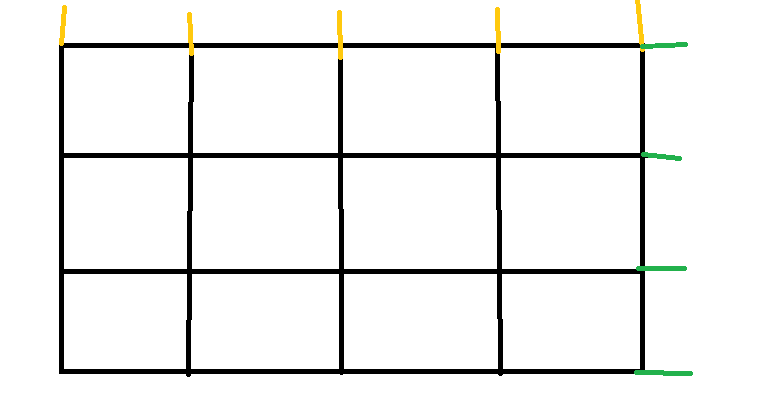
黄色的代表是列的网格线,绿色代表的是行的网格线
Grid和flex类似,布局的属性都是分为两类,一类定义在容器上,称为容器属性,一类定义在项目上,称为项目属性
2 容器属性
2.1 display属性
display:grid指定一个容器为网格布局
完整代码(复制过去就可以使用)
<!DOCTYPE html>
<html lang="en">
<head>
<meta charset="UTF-8">
<meta name="viewport" content="width=device-width, initial-scale=1.0">
<title>Document</title>
<style>
.wrapper {
width: 450px;
background: #f3f3f3;
text-align: center;
/* 定义属性 */
+ display: grid;
/* 设置列的宽度 */
+ grid-template-columns: 110px 190px 150px;
/* 设置行的高度 */
+ grid-template-rows: 50px 150px 150px
}
.item {
text-align: center;
border: 1px solid #fff;
color: #fff;
font-weight: bold;
/* line-height: 150px; */
}
.item:first-of-type {
background: #ef342a
}
.item:nth-of-type(2) {
background: #00a0a0;
}
.item:nth-of-type(3) {
background: #a0a0ff;
}
</style>
</head>
<body>
<div class="wrapper">
<div class="item">1</div>
<div class="item">2</div>
<div class="item">3</div>
</div>
</body>
</html>在这里我定义的三个网格都是宽高为150px
当然啦,我们也可以把它定义为行内元素,该元素内部就采用网格布局
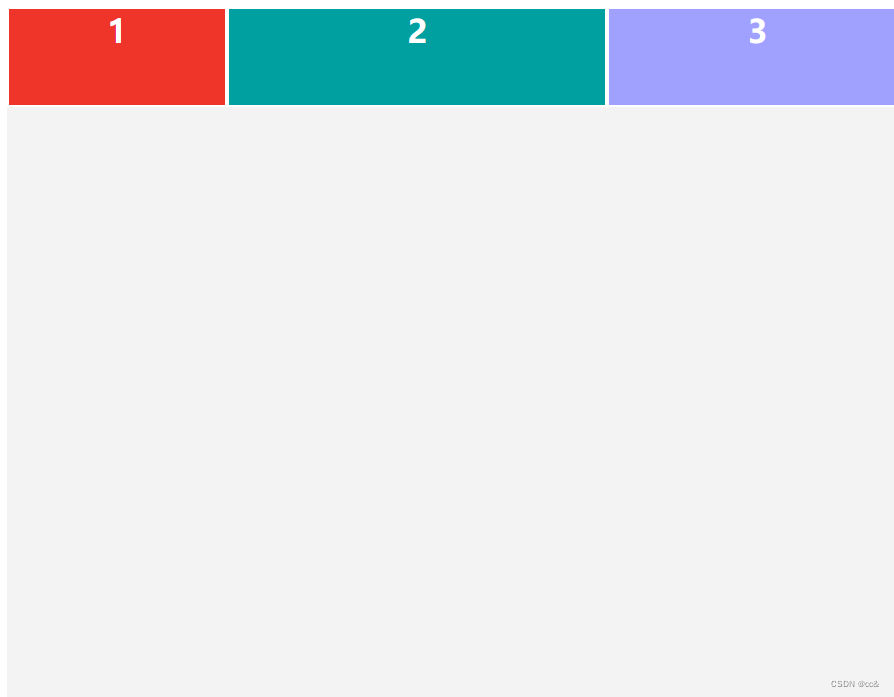
2.2 display:inline-grid效果
grid效果

inline-grid效果
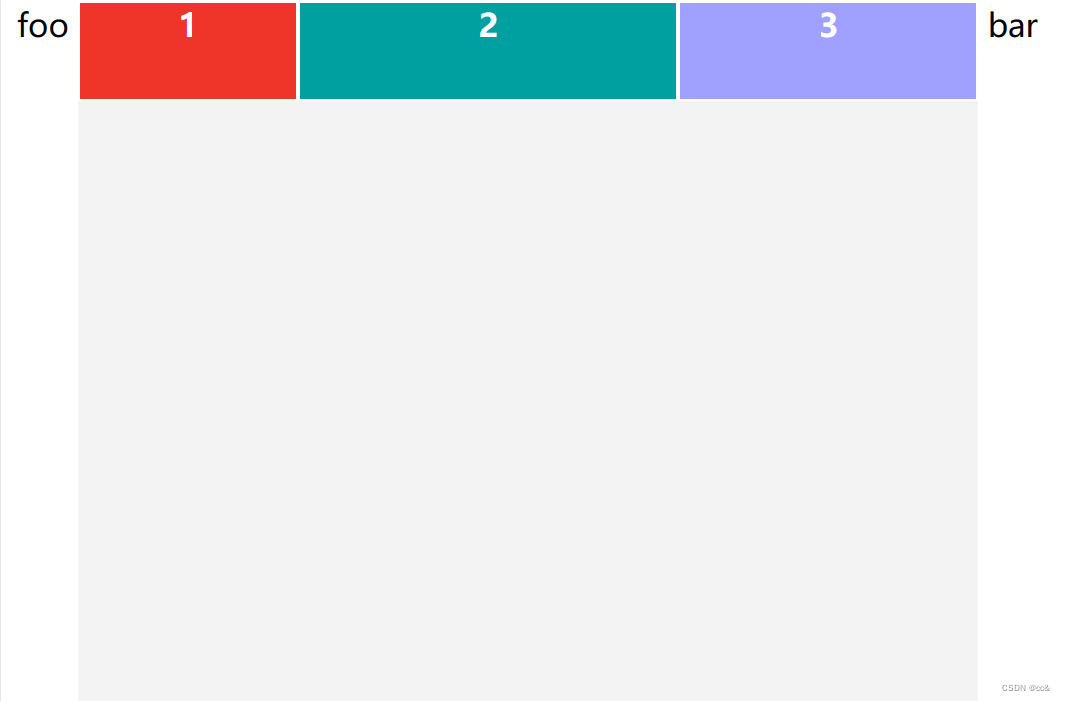
完整代码
<!DOCTYPE html>
<html lang="en">
<head>
<meta charset="UTF-8">
<meta name="viewport" content="width=device-width, initial-scale=1.0">
<title>Document</title>
<style>
.wrapper {
width: 450px;
background: #f3f3f3;
text-align: center;
/* 定义属性 */
- /* display: grid; */
+ display: inline-grid;
/* 设置列的宽度 */
grid-template-columns: 110px 190px 150px;
/* 设置行的高度 */
grid-template-rows: 50px 150px 150px
}
.item {
text-align: center;
border: 1px solid #fff;
color: #fff;
font-weight: bold;
/* line-height: 150px; */
}
.item:first-of-type {
background: #ef342a
}
.item:nth-of-type(2) {
background: #00a0a0;
}
.item:nth-of-type(3) {
background: #a0a0ff;
}
</style>
</head>
<body>
+ <span>foo</span>
<div class="wrapper">
<div class="item">1</div>
<div class="item">2</div>
<div class="item">3</div>
</div>
+ <span>bar</span>
</body>
</html>3 grid-template-columns和 grid-template-rows(行and列的比例)
grid-template-columns:用来指定行的宽度
grid-template-rows:用来指定行的高度
.wrapper{
width:450px;
background: #e5e5e5;
text-align:center;
display: inline-grid;
grid-template-columns: 150px 150px 150px;
grid-template-rows: 150px 150px 150px
}上面这段代码指定的宽高各为150px
当然来,出来能指定具体的数值之外,也可以使用百分比来表示
.wrapper {
display: grid;
grid-template-columns: 33.33% 33.33% 33.33%;
grid-template-rows: 33.33% 33.33% 33.33%;
}3.1 repeat
有时候,重复写同样的值非常麻烦,尤其网格很多时。这时,可以使用repeat()函数,简化重复的值。上面的代码用repeat()改写如下
.wrapper {
display: grid;
grid-template-columns: repeat(3, 33.33%);
grid-template-rows: repeat(3, 33.33%);
}repeat接受两个参数:第一个数重复的次数(上面的例子是重复3次),第二个是重复的值(上面例子是33.33%)
repeat也可以是重复某种模式,例如下面的例子就是一直重复100px,20px,80px
完整代码(复制可直接用)
<!DOCTYPE html>
<html lang="en">
<head>
<meta charset="UTF-8">
<meta name="viewport" content="width=device-width, initial-scale=1.0">
<title>Document</title>
<style>
#wrapper {
display: grid;
grid-template-columns: repeat(2, 100px 20px 80px);
grid-template-rows: repeat(3, 100px);
}
.item {
font-size: 4em;
text-align: center;
border: 1px solid #e5e4e9;
}
.item-1 {
background-color: #ef342a;
}
.item-2 {
background-color: #f68f26;
}
.item-3 {
background-color: #4ba946;
}
.item-4 {
background-color: #0376c2;
}
.item-5 {
background-color: #c077af;
}
.item-6 {
background-color: #f8d29d;
}
.item-7 {
background-color: #b5a87f;
}
.item-8 {
background-color: #d0e4a9;
}
.item-9 {
background-color: #4dc7ec;
}
</style>
</head>
<body>
<div id="wrapper">
<div class="item item-1">1</div>
<div class="item item-2">2</div>
<div class="item item-3">3</div>
<div class="item item-4">4</div>
<div class="item item-5">5</div>
<div class="item item-6">6</div>
<div class="item item-7">7</div>
<div class="item item-8">8</div>
<div class="item item-9">9</div>
</div>
</body>
</html>效果图
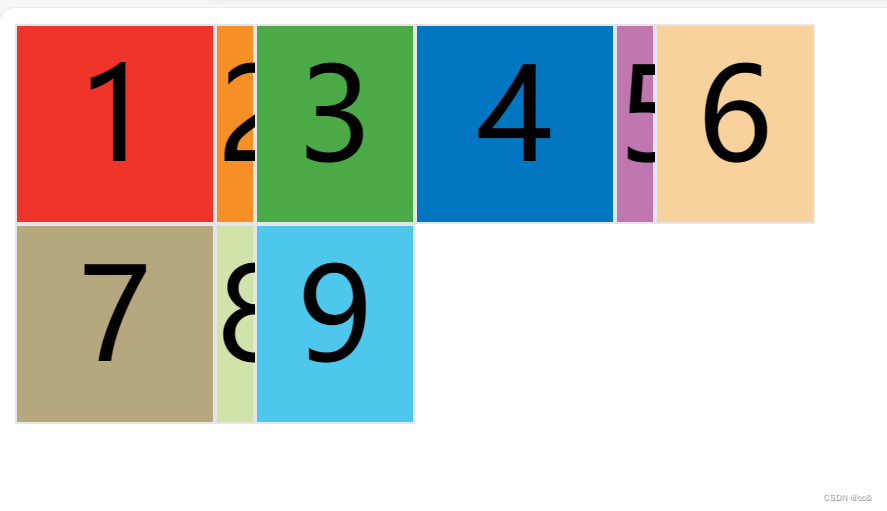
3.2 auto-fill
有时候单元格的大小是固定的,但是容器的大小不确定。如果希望每一行或则每一列都尽可能的容纳更多的单元格,我们就可以使用auto-fill来自动填充
.wrapper{
display:grid;
grid-template-columns: repeat(auto-fill, 100px)
}全部代码(复制可以直接使用)
<!DOCTYPE html>
<html lang="en">
<head>
<meta charset="UTF-8">
<meta name="viewport" content="width=device-width, initial-scale=1.0">
<title>Document</title>
<style>
#wrapper {
border: 1px solid red;
width: 400px;
display: grid;
+ grid-template-columns: repeat(auto-fill, 100px);
}
.item {
/* font-size: 4em; */
height: 100px;
text-align: center;
border: 1px solid #e5e4e9;
}
.item-1 {
background-color: #ef342a;
}
.item-2 {
background-color: #f68f26;
}
.item-3 {
background-color: #4ba946;
}
.item-4 {
background-color: #0376c2;
}
.item-5 {
background-color: #c077af;
}
.item-6 {
background-color: #f8d29d;
}
.item-7 {
background-color: #b5a87f;
}
.item-8 {
background-color: #d0e4a9;
}
.item-9 {
background-color: #4dc7ec;
}
</style>
</head>
<body>
<div id="wrapper">
<div class="item item-1">1</div>
<div class="item item-2">2</div>
<div class="item item-3">3</div>
<div class="item item-4">4</div>
<div class="item item-5">5</div>
<div class="item item-6">6</div>
<div class="item item-7">7</div>
<div class="item item-8">8</div>
<div class="item item-9">9</div>
</div>
</body>
</html>效果图
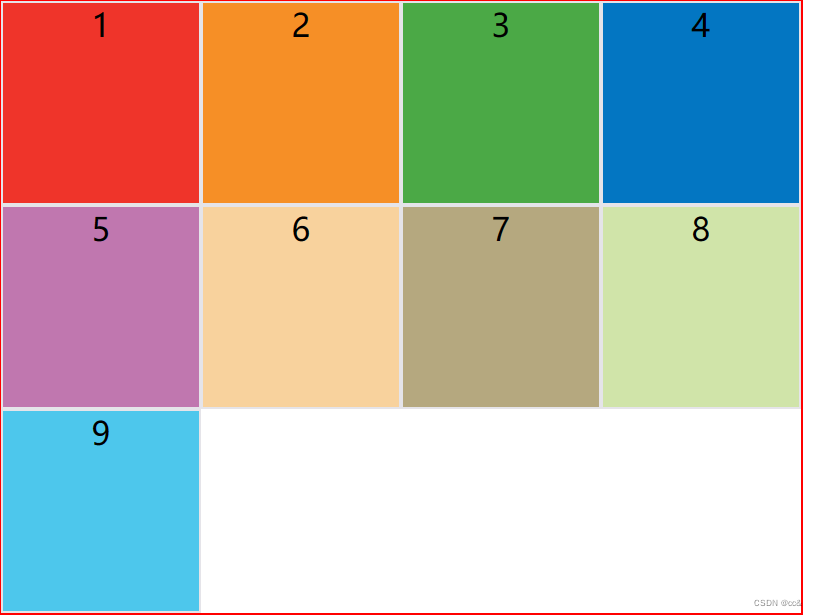
3.3 fr
为了方便表示比例关系,网格提供了fr关键字(fraction的缩写,意为“片段”),如果两列的宽度分别为1fr和2fr,就表示后者是前者的2倍
全部代码(复制可以直接使用)
<!DOCTYPE html>
<html lang="en">
<head>
<meta charset="UTF-8">
<meta name="viewport" content="width=device-width, initial-scale=1.0">
<title>Document</title>
<style>
.wrapper {
width: 450px;
background: #f3f3f3;
text-align: center;
display: grid;
+ grid-template-columns: 1fr 2fr 1fr;
grid-template-rows: 150px 150px 150px
}
.item:first-child {
background-color: red;
}
.item:nth-child(2) {
background-color: yellow;
}
.item:nth-child(3) {
background-color: green;
}
</style>
</head>
<body>
<div class="wrapper">
<div class="item">1</div>
<div class="item">2</div>
<div class="item">3</div>
</div>
</body>
</html>效果图
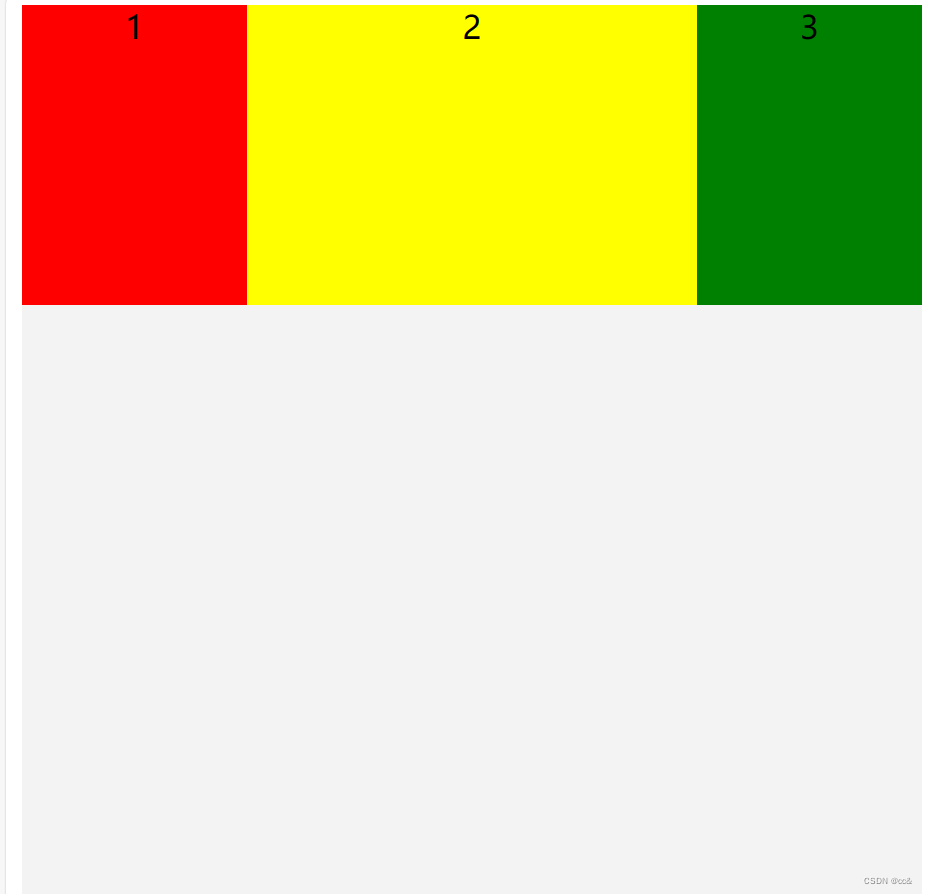
fr可以和绝对长度相结合一起使用
.wrapper {
display: grid;
grid-template-columns: 150px 1fr 2fr;
}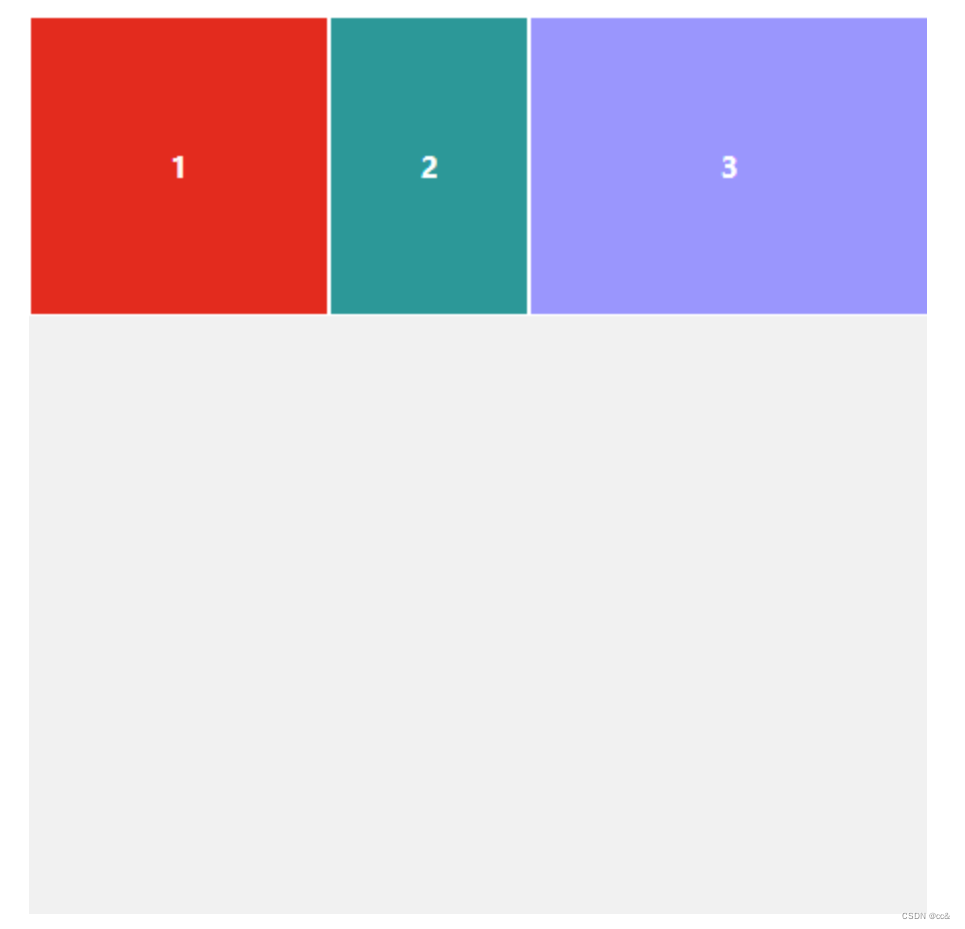
3.4 minmax
minmax() 产生一个长度范围,表示长度就在这个范围之中,它接受两个参数,分别为最小值和最大值
.wrapper{
grid-template-columns: 1fr 1fr minmax(100px,1fr);
}上面代码(minmax(100px,1fr))表示列宽不小于100px,不大于1fr
全部代码
<!DOCTYPE html>
<html lang="en">
<head>
<meta charset="UTF-8">
<meta name="viewport" content="width=device-width, initial-scale=1.0">
<title>Document</title>
<style>
.wrapper {
width: 100%;
background: #f3f3f3;
text-align: center;
display: grid;
grid-template-columns: 1fr 1fr minmax(100px, 2fr);
grid-template-rows: 150px 150px 150px
}
.item:first-child {
background-color: red;
}
.item:nth-child(2) {
background-color: yellow;
}
.item:nth-child(3) {
background-color: green;
}
</style>
</head>
<body>
<div class="wrapper">
<div class="item">1</div>
<div class="item">2</div>
<div class="item">3</div>
</div>
</body>
</html>3.5 auto关键字
表示浏览器自己决定宽度
grid-template-columns: 100px auto 100px;上面代码中,第二列的宽度,基本上等于该列单元格的最大宽度,除非单元格内容设置了min-width,且这个值大于最大宽度
全部代码(复制可用,鼠标拖动浏览器,通过浏览器宽度变化查看列宽度的变化)
<!DOCTYPE html>
<html lang="en">
<head>
<meta charset="UTF-8">
<meta name="viewport" content="width=device-width, initial-scale=1.0">
<title>Document</title>
<style>
.wrapper {
width: 100%;
background: #f3f3f3;
text-align: center;
display: grid;
+ grid-template-columns: 100px auto 100px;
grid-template-rows: 150px 150px 150px
}
.item:first-child {
background-color: red;
}
.item:nth-child(2) {
background-color: yellow;
}
.item:nth-child(3) {
background-color: green;
}
</style>
</head>
<body>
<div class="wrapper">
<div class="item">1</div>
<div class="item">2</div>
<div class="item">3</div>
</div>
</body>
</html>
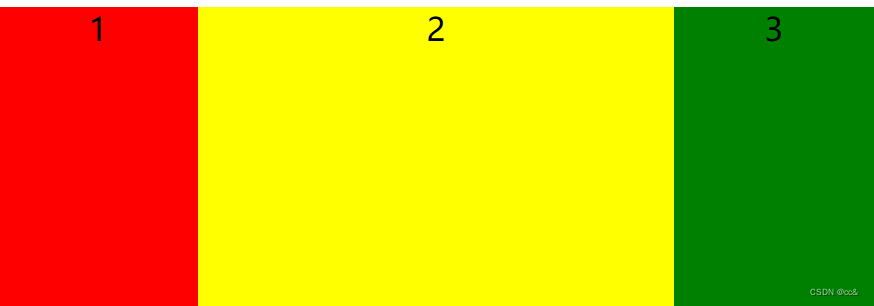
4 grid-row-gap和grid-colunm-gap属性 (行and列的间隔)
grid-row-gap:设置行与行之间的间隔
grid-colunm-gap:设置列于列之间的间隔
.wrapper {
grid-row-gap: 10px;
grid-column-gap: 10px;
}
全部代码(复制可用)
<!DOCTYPE html>
<html lang="en">
<head>
<meta charset="UTF-8">
<meta name="viewport" content="width=device-width, initial-scale=1.0">
<title>Document</title>
<style>
.wrapper {
width: 400px;
background: #f3f3f3;
text-align: center;
border: 1px solid red;
display: grid;
grid-template-columns: 1fr 1fr 1fr;
grid-template-rows: 150px 150px;
+ grid-row-gap: 10px;
+ grid-column-gap: 10px;
}
.item:first-child {
background-color: red;
}
.item:nth-child(2) {
background-color: yellow;
}
.item:nth-child(3) {
background-color: green;
}
.item:nth-child(4) {
background-color: yellow;
}
.item:nth-child(5) {
background-color: green;
}
.item:nth-child(6) {
background-color: yellow;
}
</style>
</head>
<body>
<div class="wrapper">
<div class="item">1</div>
<div class="item">2</div>
<div class="item">3</div>
<div class="item">1</div>
<div class="item">2</div>
<div class="item">3</div>
</div>
</body>
</html>grid-row-gap和grid-colunms-gap合并简写的话,格式为grid-gap
.wrapper{
grid-gap: 10px 10px;
}如果省略第二个值的话,那么就默认第二个值等于第一个值
5 grid-auto-flow 元素排序
划分网格,容器的子元素排序是按照“先行后列”来排的通过该属性我们可以自定义排列的顺序
.wrapper{
grid-auto-flow:colunm;
}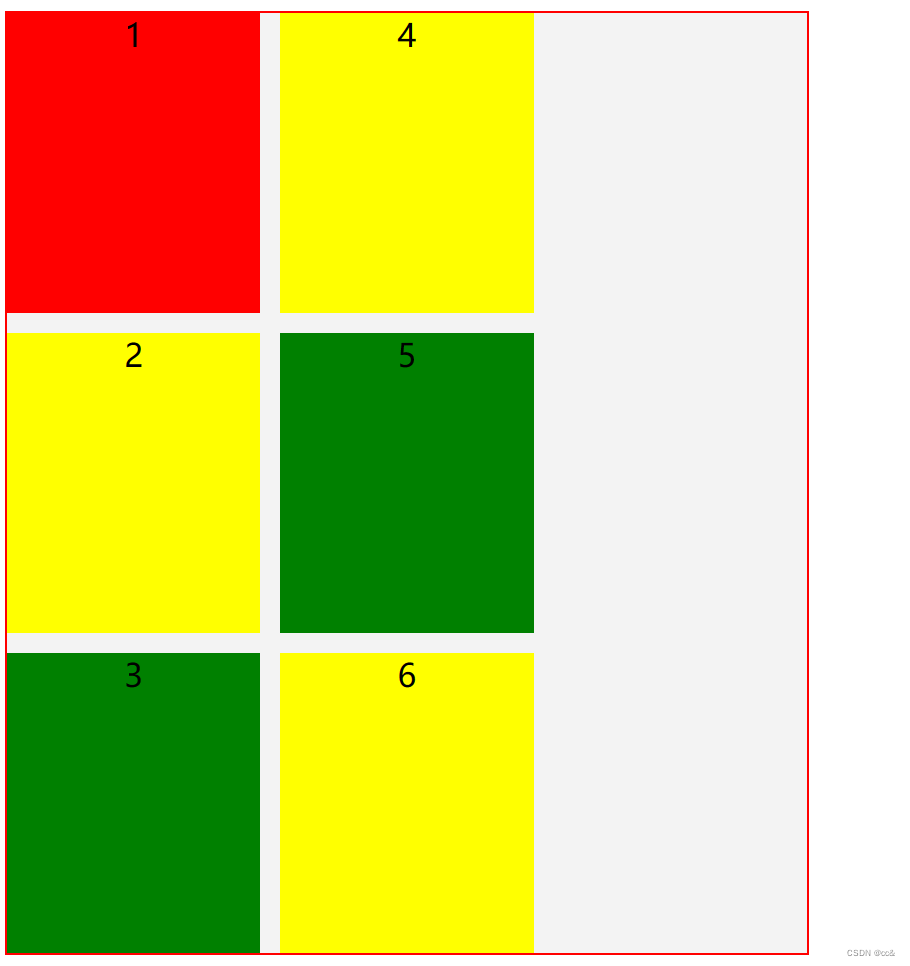
全部代码(复制可用)
<!DOCTYPE html>
<html lang="en">
<head>
<meta charset="UTF-8">
<meta name="viewport" content="width=device-width, initial-scale=1.0">
<title>Document</title>
<style>
.wrapper {
width: 400px;
background: #f3f3f3;
text-align: center;
border: 1px solid red;
display: grid;
grid-template-columns: 1fr 1fr 1fr;
grid-template-rows: 150px 150px 150px;
grid-row-gap: 10px;
grid-column-gap: 10px;
+ grid-auto-flow: column;
}
.item:first-child {
background-color: red;
}
.item:nth-child(2) {
background-color: yellow;
}
.item:nth-child(3) {
background-color: green;
}
.item:nth-child(4) {
background-color: yellow;
}
.item:nth-child(5) {
background-color: green;
}
.item:nth-child(6) {
background-color: yellow;
}
</style>
</head>
<body>
<div class="wrapper">
<div class="item">1</div>
<div class="item">2</div>
<div class="item">3</div>
<div class="item">4</div>
<div class="item">5</div>
<div class="item">6</div>
</div>
</body>
</html>6.内容的位置
6 .1 justify-items、align-items和place-items属性
justify-items属性设置单元格内容的水平位置,align-items设置单元格内容的垂直位置
.wrapper {
justify-items: start | end | center | stretch;
align-items: start | end | center | stretch;
}这两个属性的取值是完全一样的
- start:对齐单元格的起始边缘。
- end:对齐单元格的结束边缘。
- center:单元格内部居中。
- stretch:拉伸,占满单元格的整个宽度(默认值)
 全部代码(复制可用)
全部代码(复制可用)
<!DOCTYPE html>
<html lang="en">
<head>
<meta charset="UTF-8">
<meta name="viewport" content="width=device-width, initial-scale=1.0">
<title>Document</title>
<style>
.wrapper {
width: 400px;
background: #f3f3f3;
text-align: center;
border: 1px solid red;
display: grid;
grid-template-columns: 1fr 1fr 1fr;
grid-template-rows: 150px 150px 150px;
grid-row-gap: 10px;
grid-column-gap: 10px;
+ justify-items: start;
+ align-items: start;
}
.item:first-child {
width: 100px;
background-color: red;
}
.item:nth-child(2) {
background-color: yellow;
}
.item:nth-child(3) {
background-color: green;
}
.item:nth-child(4) {
background-color: yellow;
}
.item:nth-child(5) {
background-color: green;
}
.item:nth-child(6) {
background-color: yellow;
}
</style>
</head>
<body>
<div class="wrapper">
<div class="item">1</div>
<div class="item">2</div>
<div class="item">3</div>
<div class="item">4</div>
<div class="item">5</div>
<div class="item">6</div>
</div>
</body>
</html>这个是在单元中内居中
place-item是两者的合并写法 place-items: start end;
6.2 justify-content属性、align-content属性和place-content属性(针对的整体)
justify-content属性是整个内容区域在容器里面的水平位置,align-content属性是整个内容区域在容器里面的垂直位置
.wrapper {
justify-content: start | end | center | stretch | space-around | space-between | space-evenly;
align-content: start | end | center | stretch | space-around | space-between | space-evenly;
}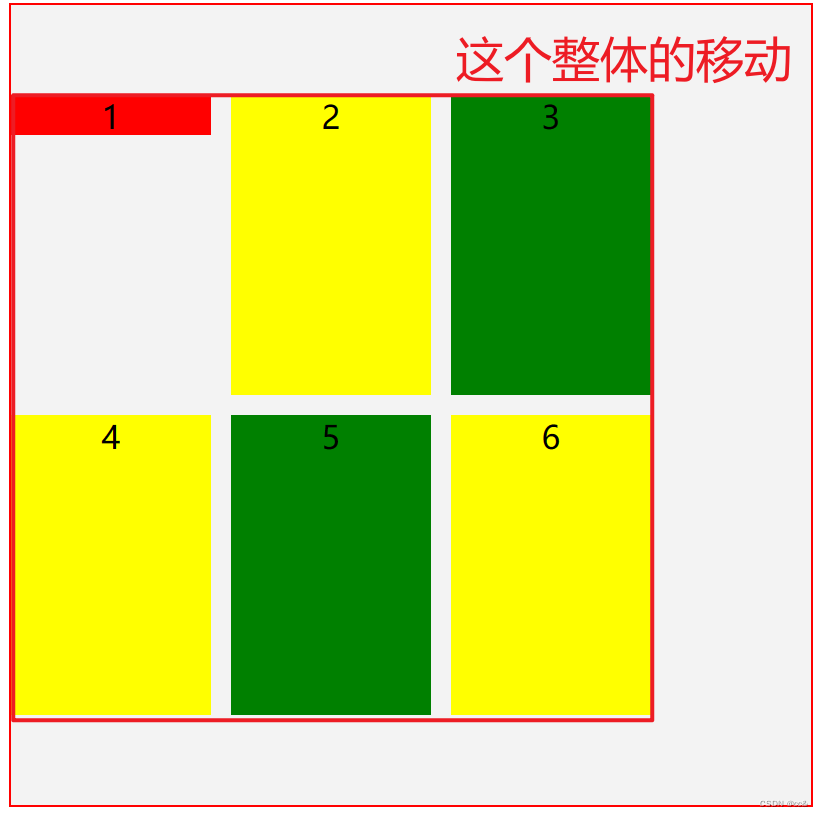
整体代码(复制可用)
<!DOCTYPE html>
<html lang="en">
<head>
<meta charset="UTF-8">
<meta name="viewport" content="width=device-width, initial-scale=1.0">
<title>Document</title>
<style>
.wrapper {
width: 400px;
height: 400px;
background: #f3f3f3;
text-align: center;
border: 1px solid red;
display: grid;
grid-template-columns: 100px 100px 100px;
grid-template-rows: 150px 150px;
grid-row-gap: 10px;
grid-column-gap: 10px;
+ justify-content: start;
+ align-content: center;
}
.item:first-child {
width: 100px;
height: 20px;
background-color: red;
}
.item:nth-child(2) {
background-color: yellow;
}
.item:nth-child(3) {
background-color: green;
}
.item:nth-child(4) {
background-color: yellow;
}
.item:nth-child(5) {
background-color: green;
}
.item:nth-child(6) {
background-color: yellow;
}
</style>
</head>
<body>
<div class="wrapper">
<div class="item">1</div>
<div class="item">2</div>
<div class="item">3</div>
<div class="item">4</div>
<div class="item">5</div>
<div class="item">6</div>
</div>
</body>
</html>7.项目属性
7.1 grid-colunm-start属性、grid-colunm-end属性、grid-row-start属性\grid-row-end属性
项目的位置是可以指定的,具体方法就是指定项目的边框,分别定位在哪根网格线
grid-column-start属性:左边框所在的垂直网格线grid-column-end属性:右边框所在的垂直网格线grid-row-start属性:上边框所在的水平网格线grid-row-end属性:下边框所在的水平网格
.item-1 {
第二列线到第四列线条
grid-column-start: 2;
grid-column-end: 4;
}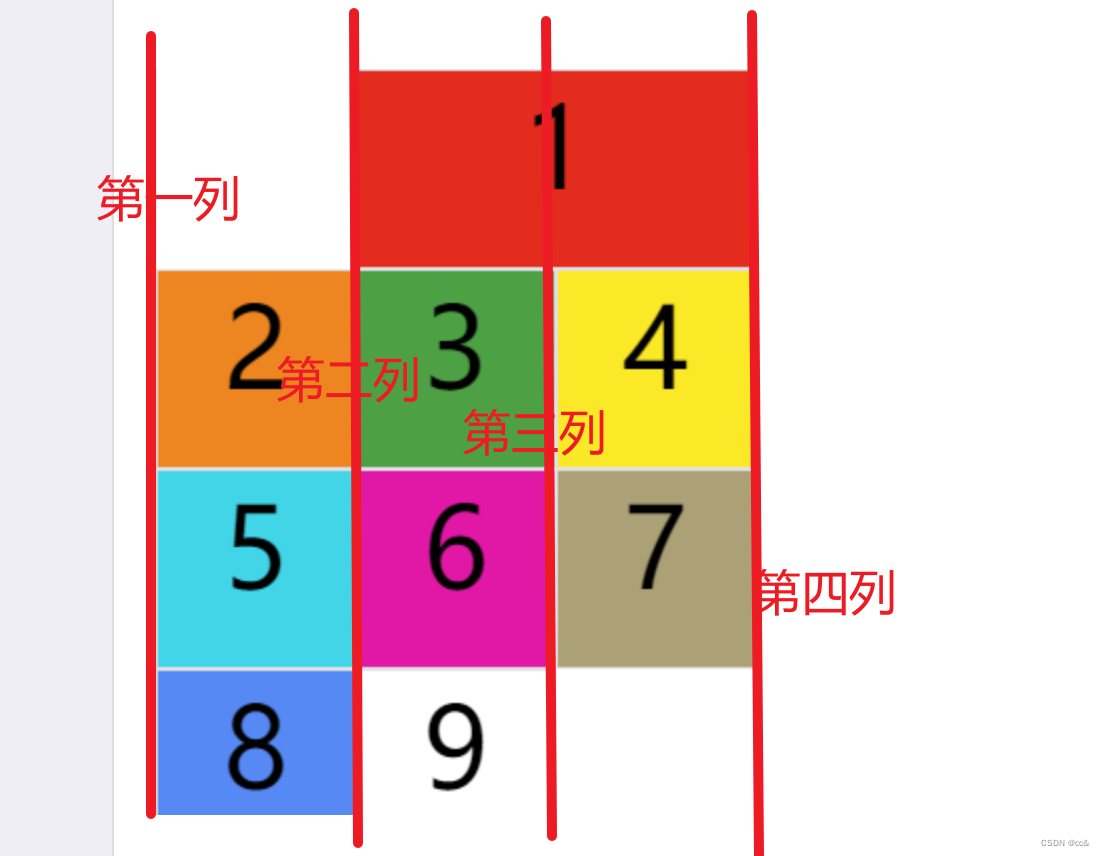
.item-1 {
grid-column-start: 1;
grid-column-end: 3;
grid-row-start: 2;
grid-row-end: 4;
} 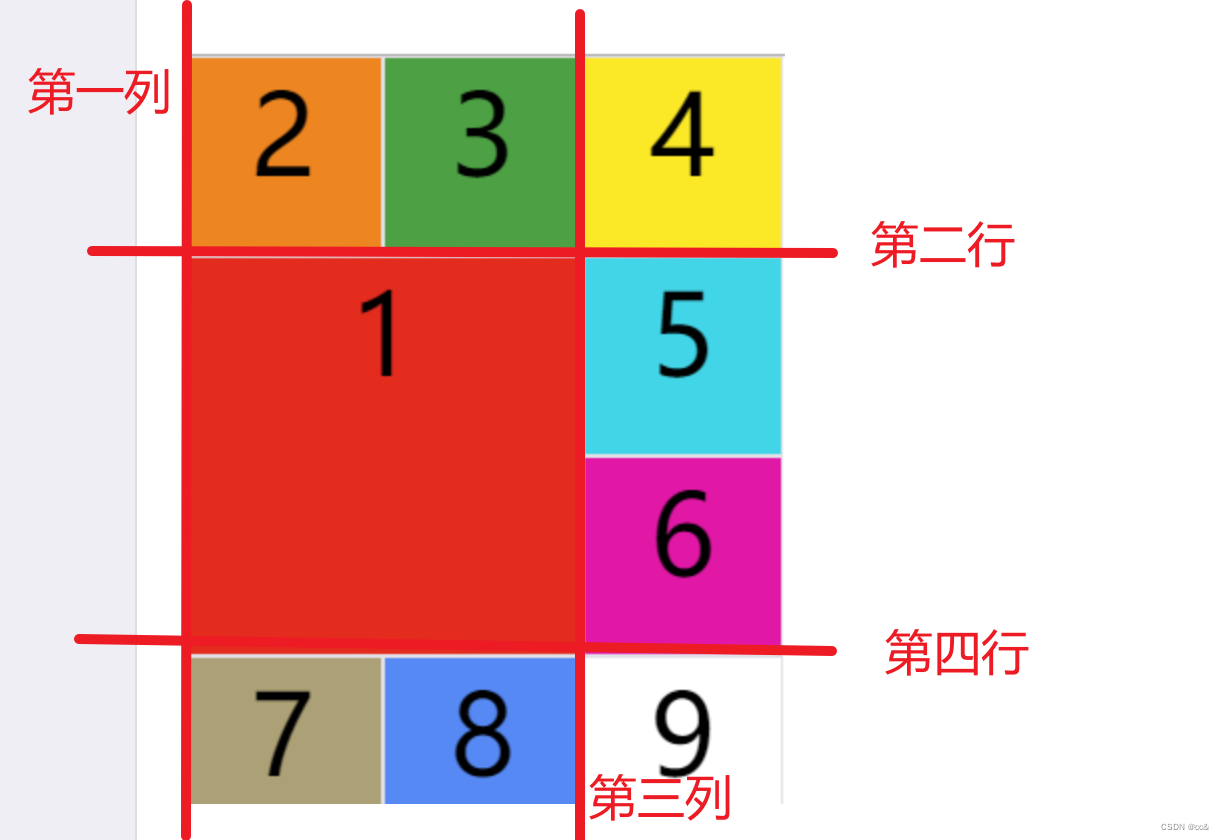
除了这个四个属性的值之外,我们还可以使用span关键字,表示占几个网格,类似table的colspan和rowspan
.item-1 {
grid-column-start: span 2;
}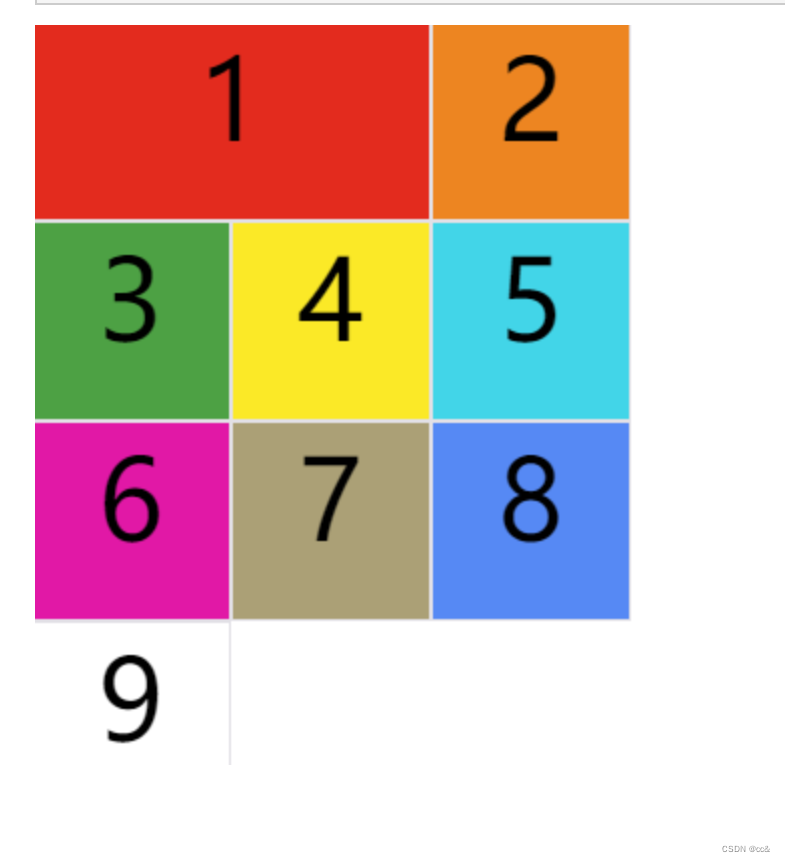
7.2 grid-column和grid-row属性
grid -column属性是grid-column-start和grid-column-end的合并写法,grid-row是grid-row-start和grid-row-end的合并写法
.item-1 {
grid-column: 1 / 3;
grid-row: 1 / 2;
}
/* 等同于 */
.item-1 {
grid-column-start: 1;
grid-column-end: 3;
grid-row-start: 1;
grid-row-end: 2;
}这两个属性也可以使用span关键字,表示跨越多少个网格
.item-1 {
background: #b03532;
grid-column: 1 / 3;
grid-row: 1 / 3;
}
/* 等同于 */
.item-1 {
background: #b03532;
grid-column: 1 / span 2;
grid-row: 1 / span 2;
}斜杠及后面的部分可以被省略,默认跨越一个网格
.item-1 {
grid-column: 1;
grid-row: 1;
}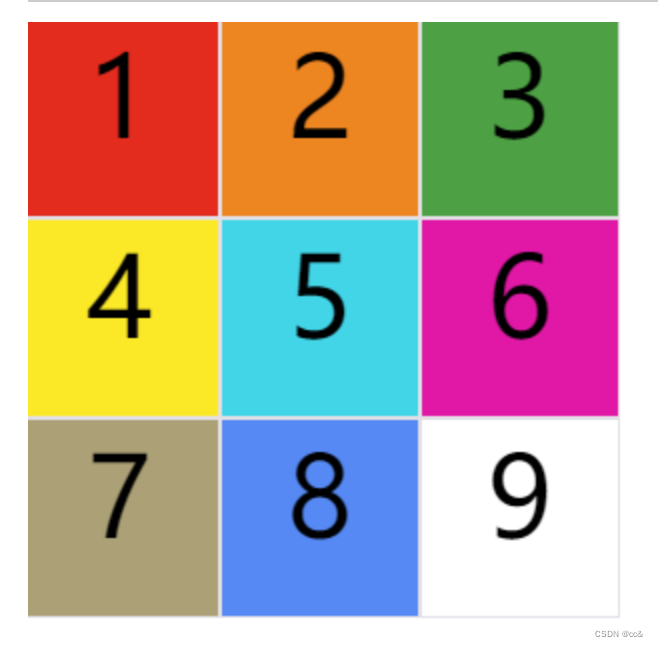
7的全部代码(复制可用,需要修改)
<!DOCTYPE html>
<html lang="en">
<head>
<meta charset="UTF-8">
<meta name="viewport" content="width=device-width, initial-scale=1.0">
<title>Document</title>
<style>
.wrapper {
width: 400px;
background: #f3f3f3;
text-align: center;
border: 1px solid red;
display: grid;
grid-template-columns: 1fr 1fr 1fr;
grid-template-rows: 100px 100px 100px 100px;
grid-row-gap: 10px;
grid-column-gap: 10px;
}
.item:first-child {
grid-column-start: 2;
grid-column-end: 4;
background-color: red;
}
.item:nth-child(2) {
background-color: yellow;
}
.item:nth-child(3) {
background-color: green;
}
.item:nth-child(4) {
background-color: yellow;
}
.item:nth-child(5) {
background-color: green;
}
.item:nth-child(6) {
background-color: yellow;
}
.item:nth-child(7) {
background-color: yellow;
}
.item:nth-child(8) {
background-color: green;
}
.item:nth-child(9) {
background-color: yellow;
}
</style>
</head>
<body>
<div class="wrapper">
<div class="item">1</div>
<div class="item">2</div>
<div class="item">3</div>
<div class="item">4</div>
<div class="item">5</div>
<div class="item">6</div>
<div class="item">7</div>
<div class="item">8</div>
<div class="item">9</div>
</div>
</body>
</html>






















 2621
2621

 被折叠的 条评论
为什么被折叠?
被折叠的 条评论
为什么被折叠?








